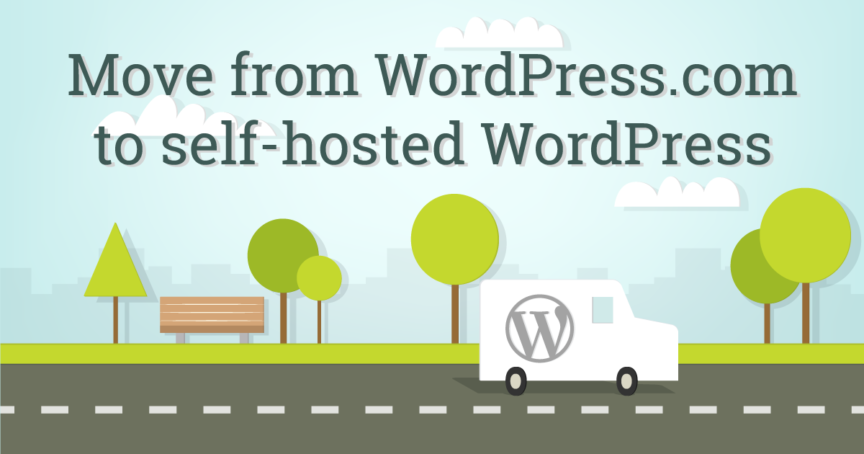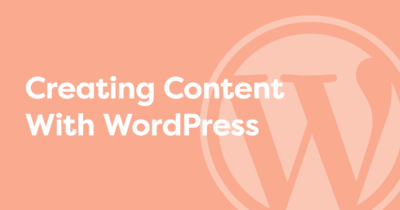WordPress.com is a service that makes it incredibly easy to start a website or blog. Indeed, millions of people around the world use the service to publish their content to the web. In fact, you may have started your own blog on WordPress.com, as I did. And you may have also begun to bump up against the limits of WordPress.com.
Like myself and so many others, you may have come to realize that there are many things you can’t do on WordPress.com. As a serious blogger or publisher, you’ll inevitably wonder if your potential to grow your readership and ultimately make some money is being limited.
The alternative, as you have no doubt heard, is the WordPress.org option – install WordPress yourself on your own server a.k.a. self-hosted WordPress. “Yikes! That sounds hard. Why would I do that?” you ask.
WordPress.com is kind of like renting a house or apartment. It’s brilliant in some respects – if your toilet starts leaking, someone else has to pay for the plumber. But you can’t, for instance, paint your walls purple, add an extra bedroom or replace all the light fittings with disco balls. In website terms, WordPress.com ensures you don’t get bothered by spam and hackers, but you can’t add star ratings to your review site or use different social sharing buttons if you need them.
Self-hosted WordPress is like buying your own place. It’s awesome in that you can do any old thing you like, such as installing an outdoor spa, building your own shed or keeping a pet goat in your spare room (probably not the best idea). But with self-hosted WordPress you also have more responsibility, like ensuring your site doesn’t crash or get hacked (luckily there are excellent services for that).
Should I stay or should I go?

So now you’re at a fork in the road – forgo some features and stay within the safe and easy walls of WordPress.com, or brave the added responsibility of self-hosted WordPress in return for all the features you need?
I found myself with this decision too. When I started my blog, I had a vague idea that I would get it up and running by myself, start writing regular posts and see where it took me. But I quickly realized that if I wanted to eventually try and make it into a serious endeavor, I’d need to upgrade to self-hosted WordPress.
After wrestling with the decision for some time, I decided to take the plunge. Here’s how I made my decision.
1. You Need Advertising
WordPress.com does not allow image ads or third-party advertising networks like Google AdSense, OpenX, Lijit, BuySellAds, and Vibrant Media, limiting my potential income. Their plans that did allow advertising start at $25/month and their in-house ads feature is limited to “bloggers with moderate to high traffic”. Sigh, not an option for my new blog. I decided after just a few months to switch over to self-hosted WordPress, where I’ve now signed up for Nuffnang (a social advertising network).
2. You Need To Grow An Email List
Building subscriber numbers is important if you want to get your readers coming back. WordPress.com includes a simple email subscription feature. Unfortunately, it’s pretty limited and you can’t personalize your sign-up forms or email design.
You also can’t embed a MailChimp sign-up form to attract subscribers, which was a major turn-off for me. From what I could see, MailChimp was one of the best ways to create newsletters at the price that I could afford, and most of the more professional bloggers seemed to be using it. After moving to self-hosted WordPress, I was able to embed (and personalize) a MailChimp sign-up form and start growing subscribers.
3. You Need Analytics And Optimization Tools
Finding out how many people are reading your site, where they’re from and which of your content they’re interested in is crucial. WordPress.com offers a great stats feature, but it does not support third party analytics such as Google Analytics (unless you are on Premium or better). You also can’t install conversion optimization and A/B testing services unless you upgrade to self-hosted WordPress.
4. You Need More Features And Designs
WordPress.com is great when you’re starting out and want to keep to a strict budget, but can be quite limiting because you can’t take advantage of plugins (add-ons for WordPress that add new features to your site).
Because I have dreams to sell an online guide or ebook in the future, I wanted to be able to use WooCommerce or Easy Digital Downloads one day. I’m not at this stage yet, but many bloggers, or businesses running websites, eventually want to allow their readers/potential customers to join in discussion forums or post reviews about their business. This can be done on the self-hosted version of WordPress, along with many other features.
I also wanted to customize my blog’s color scheme and fonts. This would have cost me $99/yr on WordPress.com, but on my self-hosted WordPress site, I installed this free theme called Astra which includes similar features at no extra cost. I have literally thousands of other themes to choose from, and can hire a designer to create a completely custom design in the future if I choose.
5. You Want To Tinker
This wasn’t a big decision point for me, but you may be someone who wants to learn about how websites work, or just have fun experimenting. While you can still learn a lot on WordPress.com, you can learn and do a lot more on a self-hosted WordPress site.
WordPress is a great platform to tinker on as well because it’s license allows and encourages tinkering, and there is a huge international community of users who learn together, help each other and create plugins and themes for WordPress. You can connect with the community through the official forums, Facebook groups, meetups and official events throughout the world.
If you’re a budding web designer, developer or even marketer, a self-hosted WordPress site is definitely the better platform to grow your skills. Just be prepared to break your site occasionally ?
Upgrade or Switch?
To be fair, a lot of these limitations are eliminated or minimized when you upgrade to WordPress.com’s $25/mo Business plan. This may seem expensive when you can get a decent hosting plan for half the price and still have more flexibility. However you also need to consider that there are many benefits included that you don’t get on self-hosted WordPress. For example you’ll have to be responsible for keeping WordPress updated and secure yourself, and these adds on to your monthly fees.
| WP.com Business Plan | Self-hosted WP | |
|---|---|---|
| Price | $25/mo | From $5/mo |
| Install your own plugins | Yes | Yes |
| Install your own themes | Yes | Yes |
| Themes included | Yes | No |
| Security included | Yes | No |
| Expert support | Yes | Depends on your host |
| Ecommerce included | Needs upgrade | Yes* |
| Flexibility | Limited | Unlimited |
Ready to switch?
Now that you’ve decided to switch, you’ll find that the biggest hurdle is the move itself. It’s a multi-step process which can be rather intimidating. Here is a high-level overview of the steps involved.
- Purchase a domain, or transfer it from WordPress.com
- Purchase a web hosting plan and install WordPress
- Export your posts, then import into the new site
- Transfer stats, blog followers and subscribers with the Jetpack plugin
And here is a DIY guide: How To Migrate From WordPress.com To WordPress.org (Self hosted).
If moving your site seems too daunting, the WordPress.com folks have a Guided Transfer service that will perform the migration for you.
ClickWP has a WordPress.com Migration service too. We’ll even throw in a complimentary 2-month support plan to make sure you settle in nicely into your new site and help you with any problems.
As I mentioned, moving is the biggest hurdle in switching to self-hosted WordPress, but it’s definitely worth it. Once you’ve completed the move, your pet goat can move into that spare bedroom and there’s nothing holding your blog back!

Picture credits




Were you reading my mind?? I have been in this dilemma for a while now and finally decided to take the plunge from wordpress.com to self-hosted. But I am completely overwhelmed by the steps involved. I registered my domain name – notanotherslipperydip from WP about a year ago but now my web hosting company is asking for login details. But how do I find out these details? She seems to think it came from GoDaddy but I don’t know what that is. Advice? Thanks so much 🙂
Hi Michaela, WP.com is a GoDaddy reseller so domains registered through them appear to be registered through GoDaddy. Here is the support document on transferring domains to a different registrar – https://en.support.wordpress.com/domains/transfer-domain-registration/
And please let us know if you need help with your migration! https://clickwp.com/migrations/
Thanks for stopping by and commenting!
I also migrated my wordpress.com to self-hosted wp. Since I’m not a tech savvy person, I searched for smb that can do the job for me. My search ended when I found the converter http://goo.gl/oVwctw. It seamlessly migrated my website conetnt, and now all my wp pages are working as they should.